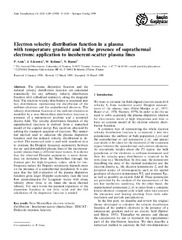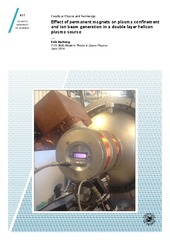Outlier classification using autoencoders: Application for fluctuation driven flows in fusion plasmas
Permanent lenke
https://hdl.handle.net/10037/15048Dato
2019-01-16Type
Journal articleTidsskriftartikkel
Peer reviewed
Sammendrag
Understanding the statistics of fluctuation driven flows in the boundary layer of magnetically confined plasmas is desired to accurately model the lifetime of the vacuum vessel components. Mirror Langmuir probes (MLPs) are a novel diagnostic that uniquely allow us to sample the plasma parameters on a time scale shorter than the characteristic time scale of their fluctuations. Sudden large-amplitude fluctuations in the plasma degrade the precision and accuracy of the plasma parameters reported by MLPs for cases in which the probe bias range is of insufficient amplitude. While some data samples can readily be classified as valid and invalid, we find that such a classification may be ambiguous for up to 40% of data sampled for the plasma parameters and bias voltages considered in this study. In this contribution, we employ an autoencoder (AE) to learn a low-dimensional representation of valid data samples. By definition, the coordinates in this space are the features that mostly characterize valid data. Ambiguous data samples are classified in this space using standard classifiers for vectorial data. In this way, we avoid defining complicated threshold rules to identify outliers, which require strong assumptions and introduce biases in the analysis. By removing the outliers that are identified in the latent low-dimensional space of the AE, we find that the average conductive and convective radial heat fluxes are between approximately 5% and 15% lower as when removing outliers identified by threshold values. For contributions to the radial heat flux due to triple correlations, the difference is up to 40%.
Beskrivelse
This article may be downloaded for personal use only. Any other use requires prior permission of the author and AIP Publishing. This article appeared in the Review of Scientific Instruments, 90, 013505, and may be found at https://doi.org/10.1063/1.5049519.
Forlag
American Institute of PhysicsSitering
Kube, R., Bianchi, F.M., Brunner, D. & LaBombard, B. (2019). Outlier classification using autoencoders: Application for fluctuation driven flows in fusion plasmas. Review of Scientific Instruments, 90, 013505. https://doi.org/10.1063/1.5049519Metadata
Vis full innførselSamlinger
Relaterte innførsler
Viser innførsler relatert til tittel, forfatter og emneord.
-
Electron velocity distribution function in a plasma with temperature gradient and in the presence of suprathermal electrons: application to incoherent-scatter plasma lines.
Guio, Patrick; Lilensten, J.; Kofman, W.; Bjørnå, Noralv (Journal article; Tidsskriftartikkel, 1998-10-31)The plasma dispersion function and the reduced velocity distribution function are calculated numerically for any arbitrary velocity distribution function with cylindrical symmetry along the magnetic field. The electron velocity distribution is separated into two distributions representing the distribution of the ambient electrons and the suprathermal electrons. The velocity distribution function of ... -
Effect of permanent magnets on plasma confinement and ion beam generation in a double layer helicon plasma source
Varberg, Erik (Master thesis; Mastergradsoppgave, 2016-06-01)The work described in this thesis was carried out to investigate how additional permanent magnets (PM) could affect the confinement and ion beam generation in a plasma which expands from a helicon source. PMs added to a plasma source systems has been shown to provide an increased plasma confinement, but is not widely used. This inexpensive and cheap method of using PMs which does not require any ... -
Level crossings, excess times, and transient plasma-wall interactions in fusion plasmas
Theodorsen, Audun; Garcia, Odd Erik (Journal article; Tidsskriftartikkel; Peer reviewed, 2016-04-19)Based on a stochastic model for intermittent fluctuations in the boundary region of magnetically confined plasmas, an expression for the level crossing rate is derived from the joint distribution of the process and its derivative. From this the average time spent by the process above a certain threshold level is obtained. This provides novel predictions of plasma–wall interactions due to transient ...


 English
English norsk
norsk


